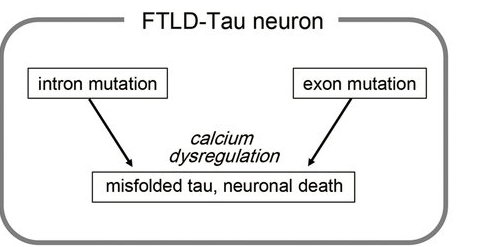カルシウム制御異常はFTLD患者由来のiPS細胞から作製したニューロンにおける神経変性の原因となる
Calcium dysregulation contributes to neurodegeneration in FTLD patient iPSC-derived neurons
2016年10月10日 Scientific Reports 6 : 34904 doi: 10.1038/srep34904

微小管結合タンパク質のタウをコードするMAPT遺伝子の変異は、家族性神経変性疾患の一種である前頭側頭葉変性症タウオパチー(FTLD-Tau)を引き起こす。FTLD-Tauは認知症を示し、脳の前頭葉と側頭葉の萎縮を特徴とする。人工多能性幹細胞(iPSC)技術により、FTLD-Tau患者のニューロンの病態をin vitroで調べられてきたが、FTLD-Tau患者のニューロンが変性するしくみについてはまだ不明である。本研究で我々は、FTLD-Tau患者由来のiPSCにNeurogenin2を発現させてニューロンに分化させ、FTLD-Tauニューロンの病態モデルを作製した。MAPT遺伝子のイントロン変異あるいはエクソン変異をもつ双方のFTLD-Tauニューロンで、折りたたみの異常なタウの蓄積と細胞外への放出が見られ、ニューロン死が起きることを見出した。これらの結果は、CRISPR/Cas9を用いてイントロン変異を修復して作製したニューロンと比較することで、確認した。FTLD-Tauニューロンでは、電気刺激により誘発される一過性細胞内Ca2+濃度上昇の調節異常が見られた。デザイナー薬剤により活性化するデザイナー受容体(designer receptors exclusively activated by designer drug; DREADD)の導入や、グルタミン酸受容体遮断薬の投与により、神経活動に関連したCa2+の細胞内への流入を化学遺伝学的あるいは薬理学的に制御することで、折りたたみの異常なタウの蓄積やニューロン死が軽減された。これらのデータは、神経活動がタウオパチーにおける神経変性を制御する可能性を示唆している。このFTLD-Tau病態モデルは、タウオパチー発症の機序に関する知見や、治療に向けた可能性をもたらすものである。
Corresponding Author
Mutations in the gene MAPT encoding tau, a microtubules-associated protein, cause a subtype of familial neurodegenerative disorder, known as frontotemporal lobar degeneration tauopathy (FTLD-Tau), which presents with dementia and is characterized by atrophy in the frontal and temporal lobes of the brain. Although induced pluripotent stem cell (iPSC) technology has facilitated the investigation of phenotypes of FTLD-Tau patient neuronal cells in vitro, it remains unclear how FTLD-Tau patient neurons degenerate. Here, we established neuronal models of FTLD-Tau by Neurogenin2-induced direct neuronal differentiation from FTLD-Tau patient iPSCs. We found that FTLD-Tau neurons, either with an intronic MAPT mutation or with an exonic mutation, developed accumulation and extracellular release of misfolded tau followed by neuronal death, which we confirmed by correction of the intronic mutation with CRISPR/Cas9. FTLD-Tau neurons showed dysregulation of the augmentation of Ca2+ transients evoked by electrical stimulation. Chemogenetic or pharmacological control of neuronal activity-relevant Ca2+ influx by the introduction of designer receptors exclusively activated by designer drugs (DREADDs) or by the treatment with glutamate receptor blockers attenuated misfolded tau accumulation and neuronal death. These data suggest that neuronal activity may regulate neurodegeneration in tauopathy. This FTLD-Tau model provides mechanistic insights into tauopathy pathogenesis and potential avenues for treatments.

